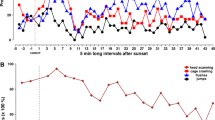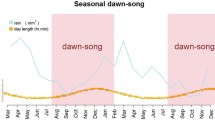Abstract
We tested whether European robins Erithacus rubecula have a time-independent stellar compass, i.e. whether they can use the stellar pattern for finding the seasonally appropriate migratory direction without reference to their internal clock. It has been claimed earlier on the basis of experiments with other nocturnal migrants, indigo buntings Passerina cyanea, pied flycatchers Ficedula hypoleuca and blackcaps Sylvia atricapilla, but none of the previous experiments was performed in the vertical magnetic field, which rules out the use of the magnetic compass, and under the natural nocturnal sky. We argue that pervious experiments allow alternative interpretations, albeit unlikely. Our data independently confirm that European robins, like other nocturnal passerine migrants hitherto studied, use their stellar compass independently of their internal clock.
Significance statement
It is generally assumed since the classic experiments of Stephen Emlen performed in the 1960s that star compass of migrating songbirds is time-independent, i.e. that the birds use the pattern of constellations and not the angle of rotation of the starry sky. However, it has not been shown unequivocally, because early experiments did not consider the possibility that the birds relied on magnetic compass rather than on time-independent stellar compass system. Here, we show that stellar compass of European robins tested in the vertical magnetic field that did not provide compass information is indeed independent of the birds’ internal clock and cannot be manipulated by resetting this clock. Cognitive challenges of learning the pattern of constellations, which is necessary to use time-independent star compass, are most fascinating and deserve detailed behavioural and neurobiological study.


Similar content being viewed by others
References
Able KP (1982) Skylight polarization patterns at dusk influence the migratory orientation of birds. Nature 299:550–551
Able KP, Cherry JD (1986) Mechanisms of dusk orientation in white-throated sparrows (Zonotrichia albicollis): clock-shift experiments. J Comp Physiol A 159:107–113
Alert B, Michalik A, Thiele N, Bottesch M, Mouritsen H (2015) Re-calibration of the magnetic compass in hand-raised European robins (Erithacus rubecula). Sci Rep 5:14323
Bolshakov CV, Shapoval AP, Zelenova NP (2001) Results of bird trapping and ringing by Biological Station “Rybachy” on the Courish Spit: long-distance recoveries of birds ringed in 1956-1997. Part 1. Non-passerines. Passerines (Alaudidae, Hirundinidae, Motacillidae, Bombicillidae, Troglodytidae, Prunellidae, Turdidae, Sylviidae, Regulidae, Muscicapidae, Aegithalidae). Avian Ecol Behav Suppl 1:1–126
Cochran WW, Mouritsen H, Wikelski M (2004) Migrating songbirds recalibrate their magnetic compass daily from twilight cues. Science 304:405–408
Emlen ST (1967a) Migratory orientation in the indigo bunting, Passerina cyanea. Part I: evidence for use of celestial cues. Auk 84:309–342
Emlen ST (1967b) Migratory orientation in the indigo bunting, Passerina cyanea. Part II: mechanism of celestial orientation. Auk 84:463–489
Emlen ST (1970) Celestial rotation: its importance in the development of migratory orientation. Science 170:1198–1201
Emlen ST (1975) The stellar-orientation system of a migratory bird. Sci Am 233:102–111
Emlen ST, Emlen JT (1966) A technique for recording migratory orientation of captive birds. Auk 83:361–367
Engels S, Hein CM, Lefeldt N, Prior H, Mouritsen H (2012) Night-migratory songbirds possess a magnetic compass in both eyes. PLoS One 7:e43271
Gwinner E (1986) Circannual rhythms in the control of avian migrations. Adv Stud Behav 16:191–228
Hein CM, Zapka M, Heyers D, Kutzschbauch S, Schneider N-L, Mouritsen H (2010) Night-migratory garden warblers can orient with their magnetic compass using the left, the right or both eyes. J R Soc Interface 7:S227–S233
Hein CM, Engels S, Kishkinev D, Mouritsen H (2011) Robins have a magnetic compass in both eyes. Nature 471:E11–E12
Holland R (2014) True navigation in birds: from quantum physics to global migration. J Zool 293:1–15
Kirschvink JL (1992) Uniform magnetic fields and double-wrapped coil systems: improved techniques for the design of bioelectromagnetic experiments. Bioelectromagnetics 13:401–411
Kishkinev D, Chernetsov N, Heyers D, Mouritsen H (2013) Migratory reed warblers need intact trigeminal nerves to correct for a 1,000 km eastward displacement. PLoS One 8:e65847
Kramer G (1951) Eine neue Methode zur Erforschung der Zugorientierung und die bisher damit erzielten Ergebnisse. Proc X Ornithol Congr Uppsala, pp:269–280
Kramer G (1953) Die Sonnenorientierung der Vögel. Zool Anz Suppl 16:72–84
Liu X, Chernetsov N (2012) Avian orientation: multi-cue integration and calibration of compass systems. Chinese Birds 3:1–8
Michalik A, Alert B, Engels S, Lefeldt N, Mouritsen H (2014) Star compass learning: how long does it take? J Ornithol 155:225–234
Moore FR (1985) Integration of environmental stimuli in the migratory orientation of the savannah sparrow (Passerculus sandwichensis). Anim Behav 33:657–663
Mouritsen H, Larsen ON (1998) Evaluating alternative methods for the analysis of Emlen funnel data. In: Mouritsen H (ed) Compasses and orientational strategies of night migrating passerine birds. Center of Sound Communication, Institute of Biology, Odense University, Odense, pp 115–124
Mouritsen H, Larsen ON (2001) Migrating songbirds tested in computer-controlled Emlen funnels use stellar cues for a time-independent compass. J Exp Biol 204:3855–3865
Muheim R, Moore FR, Phillips JB (2006a) Calibration of magnetic and celestial compass cues in migratory birds—a review of cue-conflict experiments. J Exp Biol 209:2–17
Muheim R, Phillips JB, Åkesson S (2006b) Polarized light cues underlie compass calibration in migratory songbirds. Science 313:837–839
Muheim R, Åkesson S, Phillips JB (2007) Magnetic compass of migratory Savannah sparrows is calibrated by skylight polarization at sunrise and sunset. J Ornithol 148:485–494
Sandberg R, Bäckman J, Moore FR, Lõhmus M (2000) Magnetic information calibrates celestial cues during migration. Anim Behav 60:453–463
Sauer F (1956) Zugorientierung einer Mönchsgrasmücke (Sylvia a. atricapilla, L.) unter künstlichem Sternenhimmel. Naturwissenschaften 43:231–232
Sauer F (1957) Die Sternenorientierung nächtlich ziehender Grasmücken (Sylvia atricapilla, borin und curruca). Z Tierpsychol 14:29–70
Sauer F, Sauer EM (1960) Star navigation of nocturnal migrating birds. The 1958 planetarium experiments. Cold Spring Harbour Symp Quant Biol 25:463–473
Schmidt-Koenig K (1958) Experimentelle Einflußnahme auf die 24-Stunden-Periodik bei Brieftauben und deren Auswirkungen unter besonderer Berücksichtigung des Heimfindevermögens. Z Tierpsychol 15:301–331
Schmidt-Koenig K (1961) Die Sonne als Kompaß im Heim-Orientierungssystem der Brieftauben. Z Tierpsychol 18:221–244
Weindler P, Liepa V (1999) The influence of premigratory experience on the migratory orientation of birds. In: Adams NJ, Slotow RH (eds) Proc 22nd Int Ornithol Congress. BirdLife South Africa, Johannesburg, pp 979–987
Weindler P, Wiltschko R, Wiltschko W (1996) Magnetic information affects the stellar orientation in young bird migrants. Nature 383:158–160
Weindler P, Baumetz M, Wiltschko W (1997) The direction of celestial rotation influences the development of stellar orientation in young garden warblers (Sylvia borin). J Exp Biol 200:2107–2113
Wiltschko W, Wiltschko R (1972) Magnetic compass of European robins. Science 176:62–64
Wiltschko W, Daum P, Fergenbauer-Kimmel A, Wiltschko R (1987) The development of the star compass in garden warblers, Sylvia borin. Ethology 74:285–292
Zapka M, Heyers D, Hein CM et al (2009) Visual, but not trigeminal, mediation of magnetic compass information in a migratory bird. Nature 461:1274–1277
Acknowledgements
The authors are grateful to Dmitry Kishkinev for the discussions that were most helpful when developing the idea of this study. The authors acknowledge support from Russian Foundation for Basic Research (grants 14-34-50046 and 15-04-05386 to N.C.) and the participation of the Zoological Institute of Russian Academy of Sciences (project АААА-А16-116123010004-1). The authors would also like to express gratitude to Henrik Mouritsen for allowing us to use the magnetic coils belonging to his group, even if he had no role in designing and performing this study. Constructive comments by two anonymous reviewers were instrumental when revising earlier drafts and helped identify an important flaw in an earlier version of this paper.
Author information
Authors and Affiliations
Corresponding author
Ethics declarations
The experiments were conducted in accordance with the national animal welfare legislation of Russia. Permissions for this work were given by the Kaliningrad Regional Agency for Protection, Reproduction and Use of Animal World and Forests.
Additional information
Communicated by W. Wiltschko
Rights and permissions
About this article
Cite this article
Pakhomov, A., Anashina, A. & Chernetsov, N. Further evidence of a time-independent stellar compass in a night-migrating songbird. Behav Ecol Sociobiol 71, 48 (2017). https://doi.org/10.1007/s00265-017-2279-3
Received:
Revised:
Accepted:
Published:
DOI: https://doi.org/10.1007/s00265-017-2279-3




